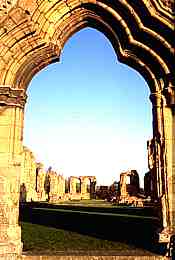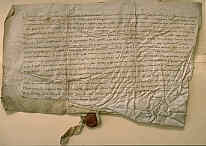 |
| Where
to Find Manuscripts (2) |
|
Certain
manuscript records, such as the chancery
or court rolls of
England, were produced for preservation and recordkeeping. Many have been
passed down through various incarnations of government agencies. The National
Archives, formerly the Public Record Office, in London holds masses
of such material. Local archives and record offices also hold a great
assortment of material which has passed through the hands of local families
or town corporations. Similarly, in other European countries, national and regional archives hold material from royal and central governments, regional centres and private collections. This material is held in public collections as a historical resource, and can usually be made available to scholars under the appropriate circumstances and with the correct arrangements made in advance. |
| Legal
or business documents from the monasteries sometimes passed into private
hands along with their books, and much has been donated back into the
public domain through libraries, local archives, universities or museums.
There is still the possibility of a tin trunk full of monastic account
books appearing from a dusty vault in a lawyer’s office. In fact nothing is impossible. It is not so many years since a previously unknown Anglo-Saxon foundation charter for a monastery appeared from a private library in the west of England. |
|
| Gratuitous picture of a romantic monastic ruin, Byland Abbey in Yorkshire, just to make the visual point that monastic archives are as damaged and scattered as their building remains. |
| Many documents are known to have survived from the middle ages into relatively modern times, only to subsequently disappear. In the 17th and 18th centuries earnest antiquarians set about copying out ancient charters, or entries from cartularies, sometimes even attempting to emulate the ancient scripts of the original, and providing illustrations of the seals. While such material must always be treated with the caution applied to any secondhand evidence, it is better, as we say in Australia, than a poke in the eye with a burnt stick. One just has to watch out for hidden agendas among the copyists. |
| An
ancient family document, a 15th century charter, formerly preserved in a private collection
in Australia. |
|
| Families still have ancient deeds or indentures among their private papers, and with the ups and downs of fickle fortune over the centuries, these are not all locked up in the libraries of stately mansions. Some may appear in a suburban bungalow near you at any time. |
| As far as England is concerned, the establishment of county archives during the 20th century has resulted in a steady trickle of private documentary material into these public collections, which are now extensive albeit dispersed all over the country. It can be difficult to actually locate specific material, as there is no guarantee that the manuscript material pertaining to your particular historical problem will be consolidated in the one archive, or even be in the most likely place, as material has travelled around over the centuries. |
|
|
|
The sheer quantity of surviving manuscript material and its dispersal through public and private collections means that any study involving original documents requires a great deal of preliminary preparation. Catalogues, descriptive lists and published material on associated topics need to be consulted extensively. Any research topic requires a good deal of selectivity in the choosing of material. Recent developments on the World Wide Web have put not only the catalogues of national collections online, but those of many other dispersed institutions. Further developments have meant that not only catalogue entries, but complete digital images of documents can be obtained for download. These types of services are steadily increasing, putting the world of medieval manuscript documents right on your own office desk. The National Archives in London is making particularly spectacular progress in making all manner of original documents available in this way. |
 |
| Segment of a petition to the crown from the Abbess of Barking (London, National Archives, E.28/74/52) from a National Archives download, by permission of the National Archives. |
| Electronic access is not restricted to legal documents, as some significant libraries have digitised entire manuscript codices and made them available online, in many cases without fee. While there is nothing like the sight and smell of the real thing, this does mean that meticulous textual work can be carried out without excessive handling of the original. |
|
|
The
bottom line is, manuscripts are everywhere. The trick is finding the particular
kinds of ones that you want to investigate, and that may involve a little
historical detective work, a lot of networking, some electronic catalogue hunting, much persistence and the capacity
to be surprised. |
|
When you do need to plunge into the archives and libraries for a look at the real thing, access
to manuscripts in public or private collections must be organised in advance.
This may involve sending letters of recommendation, and having clearly
expressed research objectives. Many archives issue passes valid only for
a limited period. The logistics of storage may restrict the number of
documents which can be seen on any particular occasion. Planning is essential, particularly if you are a long way away and an expensive air fare is involved. |
| Then, once you get there, you have to be able to read them. |
 previous page previous page |
 Why
Read It? Why
Read It? |
|
 |
 |
 |


